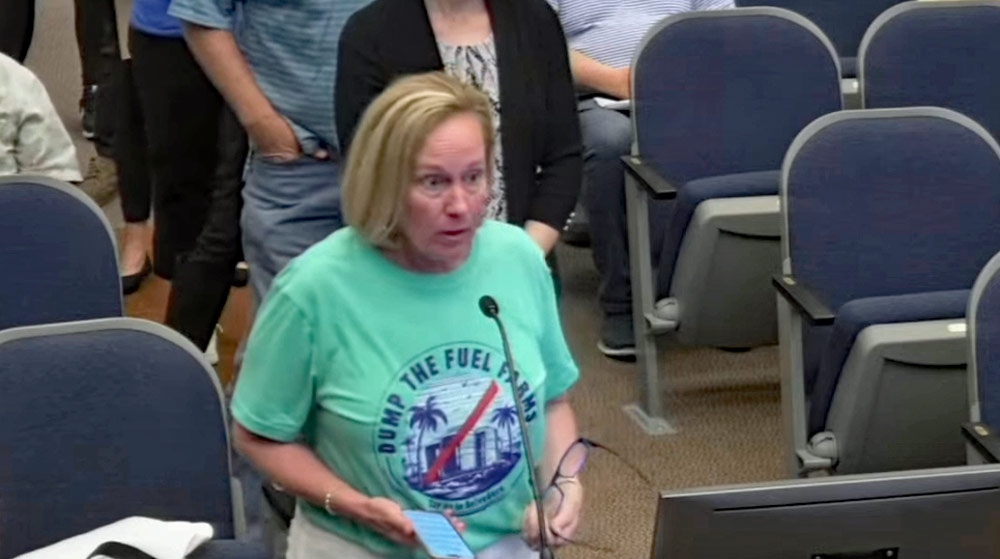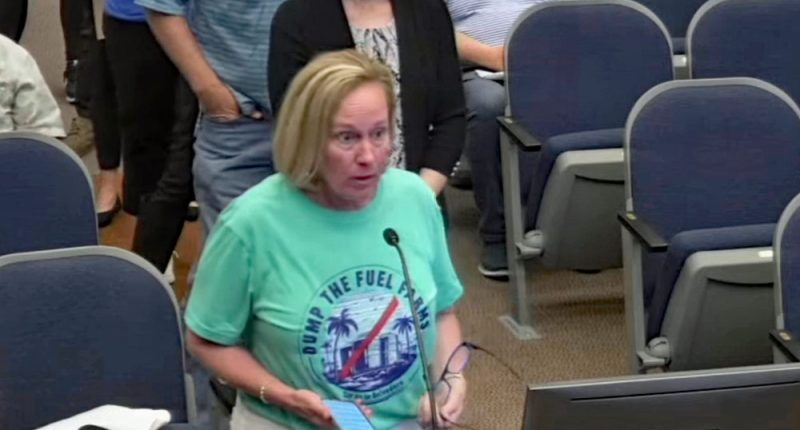
Already bruised by mounting opposition since it was announced almost two weeks ago, Palm Coast and Flagler County governments’ proposal to buy 78 acres for a 12.6-million gallon fuel farm off U.S. 1 took more fire today, this time at the County Commission, even though the county last week pulled the proposal from today’s agenda.
Numerous residents, all opposed to the fuel farm at the U.S. 1 location, addressed the commission, but commissioners themselves raised sharp questions about the plan, adding to its uncertain future.
Commissioner Leann Pennington questioned the location on safety grounds, with a potential fire closing U.S. 1 and requiring water suppression in amounts unavailable at that site. She cited as an example the 1993 fire at the Steuart Petroleum Company in Jacksonville, where a 4.5-million gallon tank of gasoline exploded, killing a security guard, and burned as 125 firefighters fought it for five days. They had the St. Johns River 1,000 feet away to draw water from. The Palm Coast site has no such resource, the city’s water treatment facility notwithstanding.
Commissioner Kim Carney didn’t see why the county had been asked to approve buying the land before Palm Coast was on board. “It sure would have been nice to have Palm Coast behind this before we actually move forward with spending the money,” Carney said.
The County Commission today was to consider approving a $10 million state Department of Commerce grant to the county, enabling it to buy the land for Belvedere Terminals, the start-up proposing to build the fuel farm. The county pulled the proposal at Palm Coast’s request after the City Council weathered acid opposition to the plan last week, especially from residents of Sawmill Branch, the subdivision immediately adjacent to the planned fuel farm.
The county pulled the item ostensibly to give Palm Coast–and Belvedere Terminals, if it were willing to look for alternatives–to analyze sites other than off Peavy Grade. Its current proposed location is right next to one of the city’s water treatment plants, near a pair of water wells, near a Florida Power and Light substation, and surrounding subdivisions, one of which was cleared for construction just last Tuesday.
Opponents, many wearing “DUMP THE FUEL FARM$” shirts, addressed commissioners for half an hour at this morning’s meeting, all calling for the commission and Palm Coast to reject the project at that location. There was less opposition to the concept, if it were placed elsewhere. “My hope is that the council ultimately rejects this project altogether, as city officials did in Ormond Beach not too long ago, and for similar reasons,” Angela Dawson said, opening the public-comment segment and citing fire hazards and the proximity to the water-treatment facility.
Residents encouraged the county and the city to press for an alternative site, and one, Ron Long, urged officials not to let the opportunity “slip by.” He appreciated the objections to the Palm Coast site, but suggested areas such as VFavoreta, further south, along the railroad. “We’ve got plenty of line, plenty of area along that line that we can put this thing,” he said, “And I think it’s important that we take advantage of it. We need to diversify our tax base by any way possible.”
Several others cited Belvedere Terminal’s lack of a track record and the checkered safety record of Grupo Mexico, the company that owns the East Florida Railroad tracks on which Belvedere’s trains will run. A Belvedere official said the company would run about one 125-car train per week to the Palm Coast facility, unloading diesel and gas there. Residents also questioned the claims that the facility would be a huge tax benefit to the city and the county. “Projections of potential tax income to Palm Coast and Flagler County cannot be substantiated,” Vicky Haley said.
County Administrator Heidi Petito estimated that the facility could bring in $800,000 a year in property taxes to the county, the city and the schools. Petito said she took half the estimated financial investment planned for the facility, divided it by half, and applied the current tax rate to calculate the figure. (Petito estimated a $90 million investment.)
Property Appraiser Jay Gardner in an interview last week said the approach was conservative and reasonable, but cautioned that he and his staff have no reference point from which to make an estimate. But they are working on it, namely by studying other fuel farms’ tax values in the state.
“First and foremost, the majority of Palm Coast residents, including myself, are against this dangerous facility to be placed within our city,” a resident who identified herself as Narina, told the commission. “Just the thought that [a] fuel farm can be next to our homes, where our children play, our elders as well, fills us with outrage, fear and deep concern. We cannot accept this severe risk that this facility will pose to most vulnerable members of our community. Secondly, we urge county to prioritize our safety and our well being over financial gains. [To] value money above people is not only unacceptable, this is betrayal of a trust that we placed you as our representatives.” She then cited the poor safety record of Grupo Mexico.
A Sawmill Branch resident warned of the effects of wildfire on the area, if firefighters had to contend with a fuel farm in the equation. “In fact, where I live now has scars from those wildfires, and now you want to build a fuel farm in the very same area,” she said. “If you could not put the [wild]fires out, then how would you put them out tomorrow, with millions of gallons of fuel added to the situation? I was wondering if perhaps God had allowed those terrible fires in 1998 so they would be a reminder to our government leaders of today of all that can go wrong that is outside of anyone’s control.”
So it went. Yet more people spoke against the proposal at the tail end of the meeting, past noon. In a text, Pennington wrote: “While I welcome much needed revenue from industry and jobs in Flagler County, I cannot support industry that we are not equipped to handle, placed on land, that if a catastrophe took place, would not have sufficient water sources nearby to fight it and could impact residents and major roadways in our county.”







